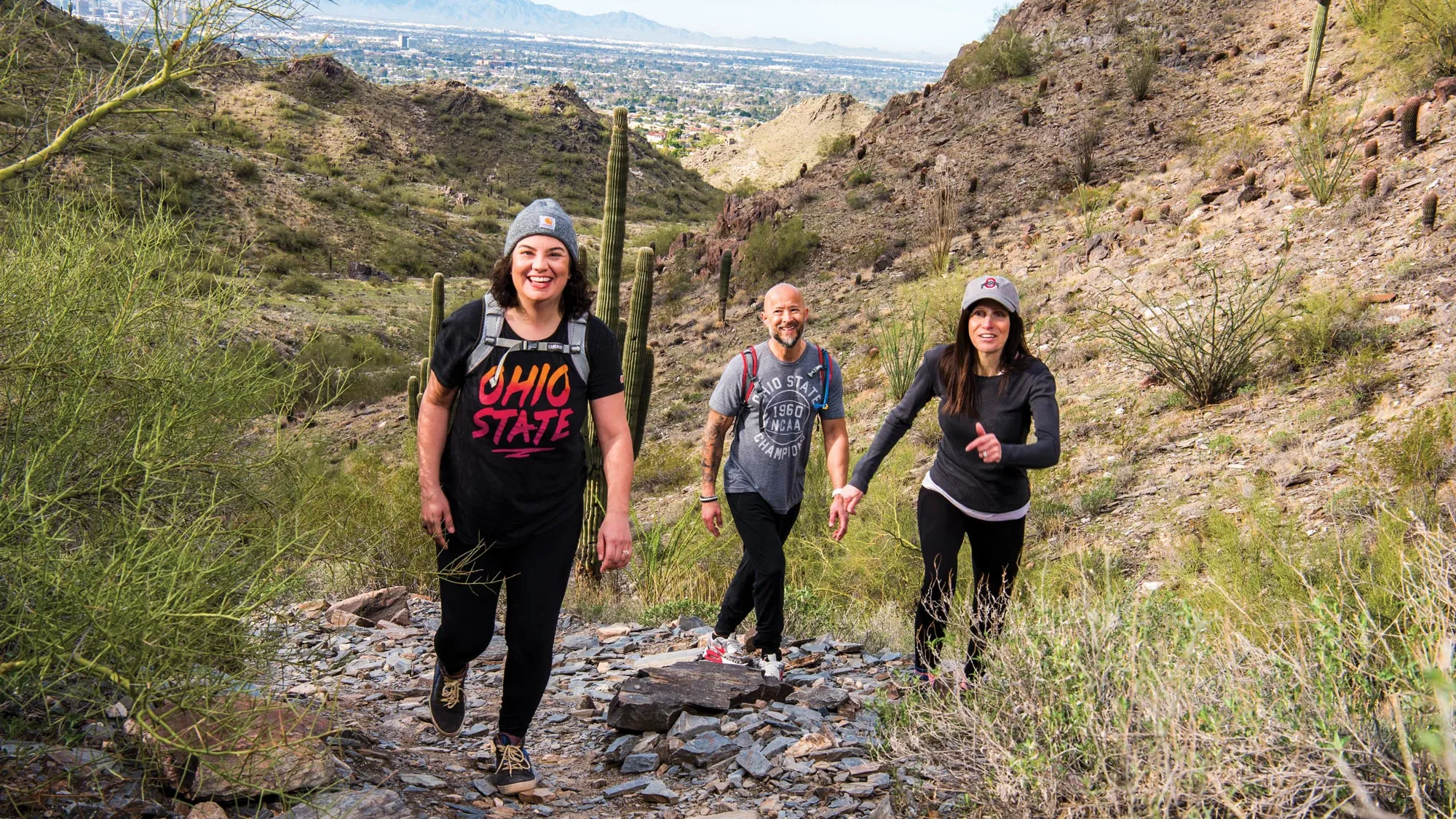Where I Live: Don’t miss Phoenix’s mountain magic
The glorious natural landscape is a star attraction in this city, ripe for hiking and simply admiring from cushier locales, alumni residents say.

Courtney Angelo Sowa, left, and Brandee Nemire stroll a path at the Desert Botanical Garden, which the pair agree is a Phoenix must-visit. (Photo by Bob Sowa)
No one can accuse the mythological phoenix of being an early bird, but you’d better get a jump on the day to see the best of the city bearing its name. That’s especially true if you plan to take in the glorious mountains that surround Phoenix.
“We have tons of mountains and hiking trails, which is one of the very unique aspects of Phoenix — you live within the mountain ranges,” says Stephanie Mastores ’05, ’09 OD. Several ranges surround Phoenix, including the McDowell, Superstition and White Tank mountains.
Brandee Nemire ’13 lives near the McDowell Mountains and likes to hike their Gateway Loop Trail. “That’s so beautiful, especially in the spring when things are starting to bloom.”
To Mastores, it seems something is blooming all the time. “You’ll see summertime flowers, especially the saguaros, but in the spring we have huge desert wildflower blooms, which are really cool. And then in the fall, other plants are blooming.”
The Phoenix Parks and Recreation and Experience Scottsdale websites are valuable resources for finding trails, but for the crown jewel of hiking in the Valley of the Sun, simply look up. Camelback Mountain, at an elevation of 2,704 feet, offers “one of the more touristy hikes that a lot of people want to do. But it’s a climb; it’s a jaunt,” Nemire says. Camelback’s two main trails are rated extremely difficult, with steep elevation gains and uneven terrain.
And remember, says Ronee Korbin Steiner ’90, intense heat from roughly July through September means “very few people ought to be hiking. And if you do, it better be darn early.”
Mastores has another word of caution: “You have to always have more water than you think. Water, water, water. You never have enough water.” And don’t forget a hat and sunscreen.
Of course, if you don’t feel inclined to climb Camelback, you can always sit back and bask in its beauty.
Kevin Fox ’95 recommends the rooftop Théa, one of five restaurants at the new Global Ambassador Hotel. Its huge outdoor patio faces Camelback, “so it is probably hands down the best happy hour viewpoint in the city,” he says.
Orange Sky, the eatery atop Talking Stick Resort, and Elements at Sanctuary are two more restaurants in the shadow of Camelback that Steiner says are worth the pricey menu. “The view, in combination with the food, you cannot miss.”
For special occasions, Nemire makes a reservation at El Chorro. She savors the deep-fried lobster, the steak and the legendary sticky buns. But her favorite part: “I love their patio because you can see Camelback Mountain — it’s right there.” She suggests booking a table for roughly 35 minutes before sunset.
Except for those intolerable summer months, Phoenix is best enjoyed outdoors, Buckeyes agree. The Desert Botanical Garden is a lovely destination.
“It’s a really unique place because you’re going to be able to see some beautiful plants in the desert,” says Courtney Angelo Sowa ’07, Alumni Club of Phoenix president. “You think of dirt and cacti, but the botanical garden has so many different plants and trees and such. It’s a really beautiful place to go.”
Ready to venture indoors? One destination is the Heard Museum, which boasts a premier collection of Native American art, a few blocks from the Phoenix Art Museum downtown.
“The Heard Museum is amazing,” Steiner says. “It’s very well-known for having one of the biggest series of American Indian art, both contemporary and traditional, and it’s very popular.”
For a museum that marches to a different beat, try the Musical Instrument Museum. Opened in 2010, the MIM features 7,500 instruments from more than 200 countries and territories around the world and offers regular concerts.
Nemire has a heads-up for Buckeyes visiting this unique museum, where patrons’ headphones deliver featured music as they approach exhibits: “There is a section on marching bands, and when you walk up, they show three different video and audio clips of marching bands. Ohio State is one of them!”
To connect with more than TBDBITL on your getaway, consider catching up with the Alumni Club of Phoenix. Sowa says the group hosts an Ohio State speaker each spring, takes part in the Big Ten Golf Classic that raises money for Make-A- Wish, organizes half a dozen football game watches and plans an annual family-friendly outing. For details, visit phoenix.alumni.osu.edu.

From left, Stephanie Mastores, Kevin Fox and Ronee Korbin Steiner hike Piestewa Peak, the Phoenix Mountains’ No. 2 peak, behind Camelback. (Photo by Geoff Reed)
Architectural wonders abound
Not everything that rises out of the desert is a mirage. Some are genuine architectural wonders.
Frank Lloyd Wright built his winter home and desert laboratory in the foothills of the McDowell Mountains in the 1930s. Taliesin West, a half- hour from downtown Phoenix, is a UNESCO World Heritage site and open to the public.
This National Historic Landmark offers a Sunset and Sips program twice a month. “From his house are beautiful sunsets, because obviously Frank Lloyd Wright was all about what you could see,” Kevin Fox says.
Adds Stephanie Mastores: “They’ve maintained it, even the furniture and everything, perfectly.” And despite development in the area since Wright’s time, “you feel like you’re by yourself in the middle of the desert, which is really cool. You can see for miles.”
An Arizona transplant like Wright, his apprentice Paolo Solieri went on to establish a name for himself as an architect and urban theorist. His home, Cosanti, built in the 1950s and ’60s, also is open to the public, as is Arcosanti, his experimental town designed for urban living that leaves a small environmental footprint. Both are about an hour north of Phoenix. Ronee Steiner describes Solieri as a visionary. Bronze wind bells he crafted can be seen throughout the Phoenix area.
In the heart of the city, another site to explore is Tovrea Castle at Carraro Heights, sometimes called the Wedding Cake Castle. “You just see it sitting there at the top of the [Loop 202] Freeway, and it’s just sort of this jewel, because it doesn’t look like it fits,” Steiner says. Built in 1928 in the Italianate style, Tovrea Castle and its cactus gardens have been restored and are open for tours, which must be booked in advance.
A few millennia older than these must-sees is the archaeological site at Phoenix’s S’edav Va’aki Museum. People known to archaeologists as the Hohokam have lived in the region for thousands of years. Museum officials say S’edav Va’aki village was settled around A.D. 500. Visitors can see a platform mound, a ballcourt and one of the irrigation systems for which the Hohokam people are renowned.



